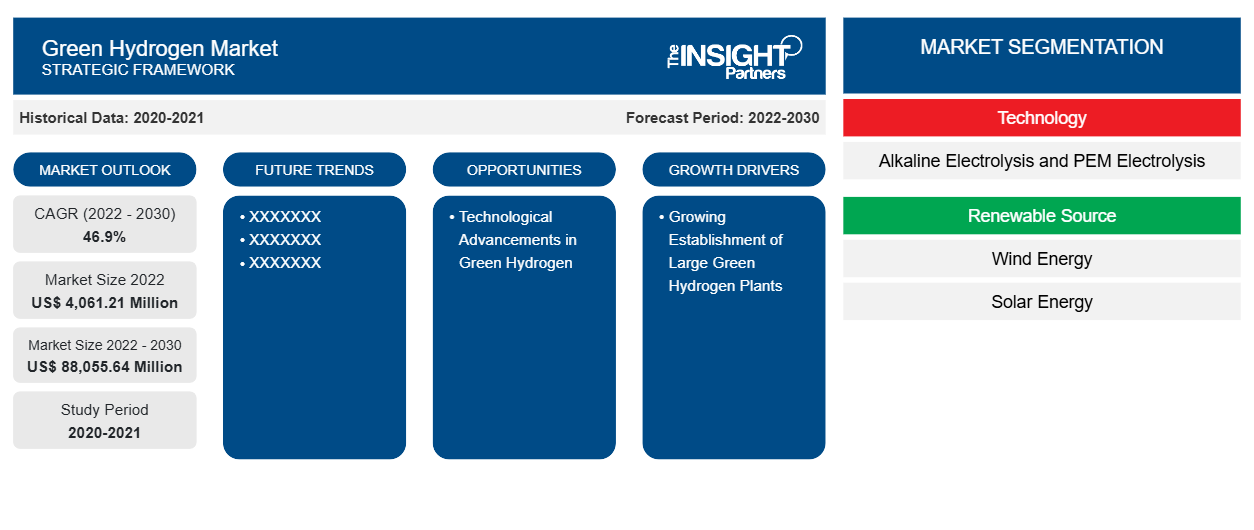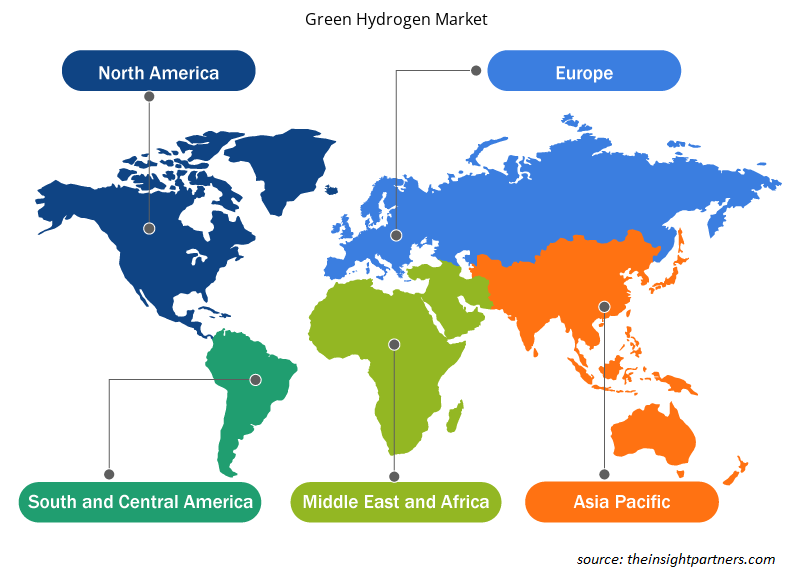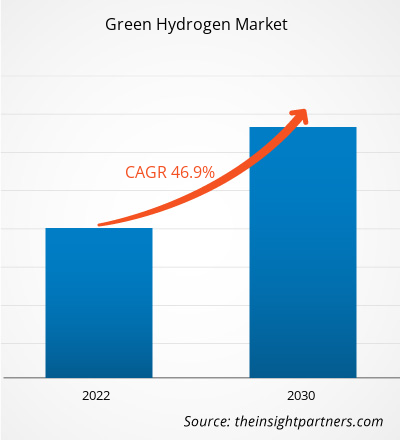Se espera que el tamaño del mercado del hidrógeno verde crezca de 8.380 millones de dólares en 2024 a 71.310 millones de dólares en 2031; se estima que registrará una CAGR del 37,8 % entre 2025 y 2031. Es probable que la creciente inversión gubernamental en energías renovables siga siendo una tendencia clave en el mercado del hidrógeno verde.
Análisis del mercado del hidrógeno verde
Gobiernos de todo el mundo reconocen las ventajas del hidrógeno verde como una solución energética limpia y sostenible. Están adoptando medidas proactivas para apoyar su desarrollo e implementación en diversos sectores. El creciente enfoque en la descarbonización y la mitigación del cambio climático impulsa a los gobiernos a priorizar las inversiones en hidrógeno verde como medio para reducir las emisiones de carbono. Por ejemplo, en junio de 2022, Protium, una de las empresas líderes en energía de hidrógeno verde del Reino Unido, ofreció soluciones integrales de energía neta cero. Por lo tanto, se prevé que el aumento de las inversiones en proyectos de hidrógeno verde genere valiosas oportunidades de expansión del mercado en los próximos años.
Panorama del mercado del hidrógeno verde
La electrólisis se utiliza para producir hidrógeno verde mediante la separación de moléculas de agua en oxígeno e hidrógeno mediante electricidad. Los avances tecnológicos en electrólisis contribuyen a mejorar la eficiencia, la rentabilidad y la escalabilidad de la producción, el almacenamiento y la utilización de hidrógeno verde. Diseños mejorados de electrolizadores, materiales catalizadores avanzados y condiciones operativas optimizadas son algunos de los factores que podrían conducir a una mayor eficiencia de conversión de energía, tiempos de respuesta más cortos y una mayor vida útil de los equipos. En julio de 2023, el Instituto Coreano de Investigación de Estándares y Ciencias (KRISS) presentó una posible solución para el procedimiento de transporte de portadores duradero y eficiente de un fotoánodo con una película protectora para desarrollar la producción de hidrógeno verde. Estos avances también están ampliando la gama de aplicaciones del hidrógeno verde. Por lo tanto, se prevé que los avances tecnológicos asociados con el hidrógeno verde impulsen el crecimiento del mercado durante el período de pronóstico.
Personalice este informe según sus necesidades
Recibirá personalización de cualquier informe, sin cargo, incluidas partes de este informe o análisis a nivel de país, paquete de datos de Excel, así como también grandes ofertas y descuentos para empresas emergentes y universidades.
Mercado del hidrógeno verde: perspectivas estratégicas

-
Obtenga las principales tendencias clave del mercado de este informe.Esta muestra GRATUITA incluirá análisis de datos, desde tendencias del mercado hasta estimaciones y pronósticos.
Impulsores y oportunidades del mercado del hidrógeno verde
La creciente demanda de FCEV favorecerá el mercado
Los vehículos eléctricos de pila de combustible (FCEV) utilizan hidrógeno como combustible y emplean pilas de combustible para producir electricidad, ofreciendo una alternativa limpia y eficiente a los vehículos tradicionales con motor de combustión interna. Con los países esforzándose por reducir las emisiones de carbono y la transición a un transporte bajo en carbono , la demanda de FCEV está aumentando en todo el mundo. Como resultado, diversos actores del mercado participan en desarrollos estratégicos, como alianzas, colaboraciones y acuerdos, para mejorar su oferta de productos y satisfacer la creciente demanda de FCEV. La adopción de FCEV impulsa la necesidad de producir hidrógeno verde, ya que es la principal fuente de combustible en estos vehículos.
Creciente establecimiento de grandes plantas de hidrógeno verde: una oportunidad en el mercado del hidrógeno verde
El establecimiento de plantas de hidrógeno verde a gran escala atrae importantes inversiones tanto del sector público como del privado. En junio de 2023, un grupo de empresas anunció su plan de invertir 79,75 dólares estadounidenses en un proyecto para la expansión de una planta de producción de hidrógeno y una planta de licuefacción de hidrógeno en Queensland, Australia. El grupo incluye a Kansai Electric Power Company (Japón), Marubeni Corporation (Japón), Iwatani Corporation (Japón), Keppel Infrastructure (Singapur) y Stanwell Corporation (Australia). Se espera que el auge en el desarrollo de infraestructura cree un entorno favorable para la implementación del hidrógeno verde en diferentes sectores, lo que probablemente ofrecerá perspectivas de crecimiento a los actores del mercado durante el período de pronóstico.
Análisis de segmentación del informe de mercado de hidrógeno verde
Los segmentos clave que contribuyeron a la derivación del análisis del mercado del hidrógeno verde son la tecnología, las fuentes renovables y el uso final.
- Según la tecnología, el mercado del hidrógeno verde se ha dividido en electrólisis alcalina y electrólisis PEM. El segmento de electrólisis alcalina tuvo una mayor participación de mercado en 2022.
- En cuanto a las fuentes renovables, el mercado se ha segmentado en energía eólica, energía solar y otras. El segmento de la energía solar dominó el mercado en 2022.
- En cuanto a la industria de uso final, el mercado se ha segmentado en los sectores químico, energético, de alimentos y bebidas, médico, petroquímico, entre otros. El segmento energético dominó el mercado en 2022.
Análisis de la cuota de mercado del hidrógeno verde por geografía
El alcance geográfico del informe del mercado del hidrógeno verde se divide principalmente en cinco regiones: América del Norte, Asia Pacífico, Europa, Medio Oriente y África, y América del Sur/América del Sur y Central.
Europa lideró el mercado del hidrógeno verde. Varios países europeos, como España, Francia, Alemania y Portugal, han tomado medidas para cooperar y construir un gasoducto de hidrógeno para 2030. Este gasoducto facilitará el transporte de aproximadamente 2 millones de toneladas métricas de hidrógeno al año desde estos países a Francia. A medida que Europa busca asegurar su suministro energético y acelerar la transición hacia un futuro sin emisiones de carbono, el hidrógeno verde emerge como un recurso vital y una solución clave para reducir la dependencia de los combustibles fósiles y alcanzar ambiciosos objetivos climáticos. Alemania, Francia, Italia y el Reino Unido son algunos de los principales países que operan en el mercado del hidrógeno verde en Europa. El gobierno alemán ya ha tomado medidas para promover la economía del hidrógeno, incluyendo la adopción de una Estrategia Nacional del Hidrógeno. Por ejemplo, en marzo de 2022, Alemania anunció la contribución de 572 millones de dólares estadounidenses a una nueva economía global del hidrógeno verde. Este es un paso significativo en la promoción de la adopción y el desarrollo de soluciones de energía limpia en todo el mundo.
Perspectivas regionales del mercado del hidrógeno verde
Los analistas de Insight Partners han explicado detalladamente las tendencias y los factores regionales que influyen en el mercado del hidrógeno verde durante el período de pronóstico. Esta sección también analiza los segmentos y la geografía del mercado del hidrógeno verde en Norteamérica, Europa, Asia Pacífico, Oriente Medio y África, y Sudamérica y Centroamérica.

- Obtenga los datos regionales específicos para el mercado del hidrógeno verde
Alcance del informe del mercado del hidrógeno verde
| Atributo del informe | Detalles |
|---|---|
| Tamaño del mercado en 2024 | US$ 8.38 mil millones |
| Tamaño del mercado en 2031 | US$ 71.31 mil millones |
| CAGR global (2025-2031) | 37,8% |
| Datos históricos | 2021-2023 |
| Período de pronóstico | 2025-2031 |
| Segmentos cubiertos |
Por tecnología
|
| Regiones y países cubiertos |
América del norte
|
| Líderes del mercado y perfiles de empresas clave |
|
Densidad de actores del mercado del hidrógeno verde: comprensión de su impacto en la dinámica empresarial
El mercado del hidrógeno verde está creciendo rápidamente, impulsado por la creciente demanda del usuario final debido a factores como la evolución de las preferencias de los consumidores, los avances tecnológicos y un mayor conocimiento de los beneficios del producto. A medida que aumenta la demanda, las empresas amplían su oferta, innovan para satisfacer las necesidades de los consumidores y aprovechan las tendencias emergentes, lo que impulsa aún más el crecimiento del mercado.
La densidad de actores del mercado se refiere a la distribución de empresas o compañías que operan en un mercado o sector en particular. Indica cuántos competidores (actores del mercado) hay en un mercado determinado en relación con su tamaño o valor total.
Las principales empresas que operan en el mercado del hidrógeno verde son:
- Aire líquido
- Siemens Energía
- Cummins Inc.
- Linde Plc
- NEL ASA
- ?rsted A/S
Descargo de responsabilidad : Las empresas enumeradas anteriormente no están clasificadas en ningún orden particular.

- Obtenga una descripción general de los principales actores clave del mercado del hidrógeno verde
Noticias y desarrollos recientes del mercado del hidrógeno verde
El mercado del hidrógeno verde se evalúa mediante la recopilación de datos cualitativos y cuantitativos tras la investigación primaria y secundaria, que incluye importantes publicaciones corporativas, datos de asociaciones y bases de datos. A continuación, se presenta una lista de las novedades en el mercado en cuanto a innovación, expansión empresarial y estrategias:
- En octubre de 2022, NTPC y Siemens Ltd firmaron un Memorando de Entendimiento (MdE) para la viabilidad de demostrar la co-combustión de hidrógeno mezclado con gas natural en las turbinas de gas Siemens V94.2 instaladas en la central eléctrica de gas de NTPC en Faridabad. (Fuente: Siemens Ltd, Comunicado de prensa/Sitio web de la empresa/Boletín informativo)
- En diciembre de 2022, Cummins Inc. suministró un sistema electrolizador de membrana de intercambio de protones (PEM) de 35 megavatios (MW) para la nueva planta de producción de hidrógeno de Linde en las Cataratas del Niágara, Nueva York. (Fuente: Cummins Inc., Comunicado de prensa/Sitio web de la empresa/Boletín informativo)
Cobertura y resultados del informe del mercado del hidrógeno verde
El informe "Tamaño y pronóstico del mercado del hidrógeno verde (2020-2030)" ofrece un análisis detallado del mercado que abarca las siguientes áreas:
- Tamaño del mercado de hidrógeno verde y pronóstico a nivel global, regional y nacional para todos los segmentos clave del mercado cubiertos bajo el alcance
- Dinámica del mercado, como impulsores, restricciones y oportunidades clave
- Tendencias del mercado del hidrógeno verde
- Análisis PEST y FODA detallado
- Análisis del mercado de hidrógeno verde que abarca las tendencias clave del mercado, el marco global y regional, los principales actores, las regulaciones y los desarrollos recientes del mercado.
- Análisis de la industria, el panorama y la competencia del mercado del hidrógeno verde, que abarca la concentración del mercado, el análisis de mapas de calor, los actores destacados y los desarrollos recientes.
- Perfiles detallados de empresas
- Análisis histórico (2 años), año base, pronóstico (7 años) con CAGR
- Análisis PEST y FODA
- Tamaño del mercado, valor/volumen: global, regional y nacional
- Industria y panorama competitivo
- Conjunto de datos de Excel
Informes recientes
Testimonios
Razón para comprar
- Toma de decisiones informada
- Comprensión de la dinámica del mercado
- Análisis competitivo
- Información sobre clientes
- Pronósticos del mercado
- Mitigación de riesgos
- Planificación estratégica
- Justificación de la inversión
- Identificación de mercados emergentes
- Mejora de las estrategias de marketing
- Impulso de la eficiencia operativa
- Alineación con las tendencias regulatorias






















 Obtenga una muestra gratuita para - Mercado del hidrógeno verde
Obtenga una muestra gratuita para - Mercado del hidrógeno verde